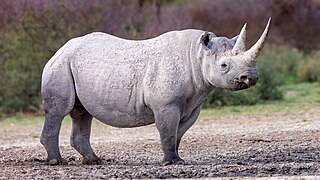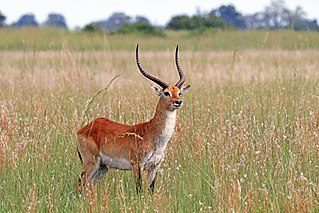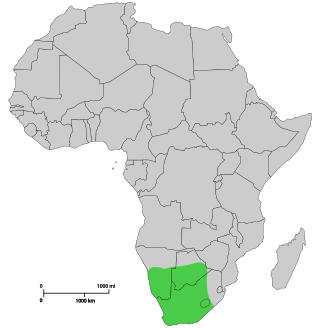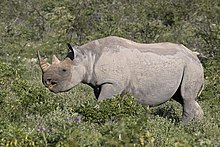
Perissodactyla is an order of ungulates. The order includes about 17 living species divided into three families: Equidae, Rhinocerotidae (rhinoceroses), and Tapiridae (tapirs). They typically have reduced the weight-bearing toes to three or one of the five original toes, though tapirs retain four toes on their front feet. The nonweight-bearing toes are either present, absent, vestigial, or positioned posteriorly. By contrast, artiodactyls bear most of their weight equally on four or two of the five toes: their third and fourth toes. Another difference between the two is that odd-toed ungulates digest plant cellulose in their intestines, rather than in one or more stomach chambers as even-toed ungulates, with the exception of Suina, do.

In Africa, the Big five game animals are the lion, leopard, rhinoceros, elephant, and African buffalo. The term was coined by big-game hunters to refer to the five most difficult animals in Africa to hunt on foot, but is now more widely used by game viewing tourists and safari tour operators. They are examples of charismatic megafauna, featuring prominently in popular culture, and are among the most famous of Africa's large animals.

The black rhinoceros, black rhino or hook-lipped rhinoceros is a species of rhinoceros, native to eastern and southern Africa including Angola, Botswana, Kenya, Malawi, Mozambique, Namibia, South Africa, Eswatini, Tanzania, Zambia, and Zimbabwe. Although the species is referred to as black, its colours vary from brown to grey. It is the only extant species of the genus Diceros.

A rhinoceros, commonly abbreviated to rhino, is a member of any of the five extant species of odd-toed ungulates in the family Rhinocerotidae; it can also refer to a member of any of the extinct species of the superfamily Rhinocerotoidea. Two of the extant species are native to Africa, and three to South and Southeast Asia.

Diceros is a genus of rhinoceros containing the extant black rhinoceros (Diceros bicornis) and several extinct species.

The Cape bushbuck, also known as imbabala is a common, medium-sized bushland-dwelling, and a widespread species of antelope in sub-Saharan Africa. It is found in a wide range of habitats, such as rain forests, montane forests, forest-savanna mosaic, savanna, bushveld, and woodland. Its stands around 90 cm (35 in) at the shoulder and weigh from 45 to 80 kg. They are generally solitary, territorial browsers.

The white rhinoceros, white rhino or square-lipped rhinoceros is the largest extant species of rhinoceros. It has a wide mouth used for grazing and is the most social of all rhino species. The white rhinoceros consists of two subspecies: the southern white rhinoceros, with an estimated 16,803 wild-living animals, and the much rarer northern white rhinoceros. The northern subspecies has very few remaining individuals, with only two confirmed left in 2018, both in captivity. Sudan, the world's last known male Northern white rhinoceros, died in Kenya on 19 March 2018 at age 45.

The lechwe, red lechwe, or southern lechwe is an antelope found in wetlands of south-central Africa.

The Kaokoveld Desert is a coastal desert of northern Namibia and southern Angola.

Burchell's zebra is a southern subspecies of the plains zebra. It is named after the British explorer and naturalist William John Burchell. Common names include bontequagga, Damaraland zebra, and Zululand zebra. Burchell's zebra is the only subspecies of zebra which may be legally farmed for human consumption.

The suni is a small antelope. It occurs in dense underbrush from central Kenya to KwaZulu-Natal in South Africa.

The eastern black rhinoceros, also known as the East African black rhinoceros, is a subspecies of the black rhinoceros. Its numbers are very low due to poaching for its horn, and it is listed as critically endangered.

The western black rhinoceros or West African black rhinoceros is an extinct subspecies of the black rhinoceros. It was declared extinct by the IUCN in 2011. The western black rhinoceros was believed to have been genetically different from other rhino subspecies. It was once widespread in the savanna of sub-Saharan Africa, but its numbers declined due to poaching. The western black rhinoceros resided primarily in Cameroon, but surveys since 2006 have failed to locate any individuals.

The south-central black rhinoceros, also known as the south-central hook-lipped rhinoceros or the lesser black rhino, is a subspecies of the black rhinoceros. In keeping with the rules of zoological nomenclature, the south-central black rhinoceros should be known as Diceros bicornis keitloa, a nomen novum. Although it is the most numerous of the black rhinoceros subspecies, it is nevertheless designated as critically endangered on the IUCN Red List. Like other black rhinoceros subspecies, it has a prehensile lip and lives in savanna habitat.

The southern black rhinoceros, southern hook-lipped rhinoceros or Cape rhinoceros is an extinct subspecies of the black rhinoceros that was once abundant in South Africa from the Cape Province to Transvaal, southern Namibia, and possibly also Lesotho and southern Botswana. Zoos, animal sanctuaries and conservation centers use this same scientific name as an indicating reference to the surviving south-central black rhinoceros. This former species was brought to extinction by excessive hunting and habitat destruction around 1850.

The Mongalla gazelle is a species of gazelle found in the floodplain and savanna of South Sudan. It was first described by British zoologist Walter Rothschild in 1903. The taxonomic status of the Mongalla gazelle is widely disputed. While some authorities consider it a full-fledged monotypic species in the genus Eudorcas, it is often considered a subspecies of Thomson's gazelle, while other authorities regard it as subspecies of the red-fronted gazelle.

The southern white rhinoceros, or southern white rhino is one of the two subspecies of the white rhinoceros. It is the most common and widespread subspecies of rhinoceros.

The Namibian savanna woodlands, also known as the Namib escarpment woodlands, are the deserts and xeric shrublands ecoregion of Namibia and Angola.
The Uganda black rhinoceros is a subspecies of the black rhinoceros that was native to parts of South Sudan, Uganda, Kenya, and Ethiopia, but is currently limited to a select few Kenyan nature reserves. It is unknown if the subspecies is extinct or not.



















